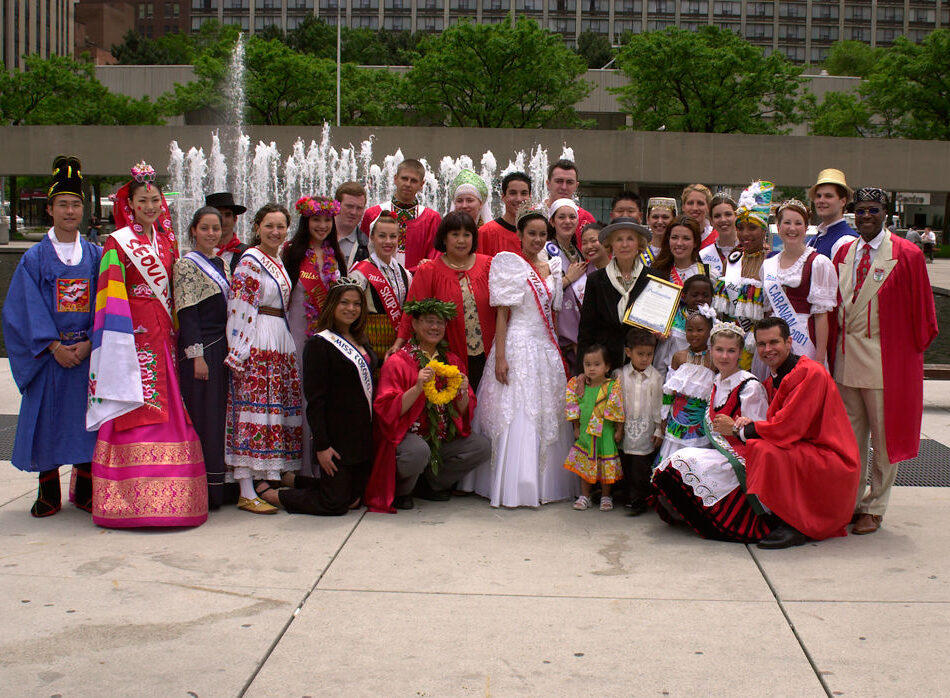
The Toronto Caravan: A Festival for Everyone
In the 1960s, Zena and Leon Kossar worked with the Community Folk Arts Council to create the Metro Toronto International Caravan Festival, celebrating Toronto’s rich cultural diversity and representing a communal embracing of the city’s dynamic heritage for 35 years.
Contents
This story was researched and written by Emerging Historian Phoebe Croft (2023) under the Equity Heritage Initiative made possible by the generous support of our Tours Program Presenting Sponsor, TD Bank Group through the TD Ready Commitment.
Last updated: April 4, 2024
We’d love to hear your feedback. Contact us.
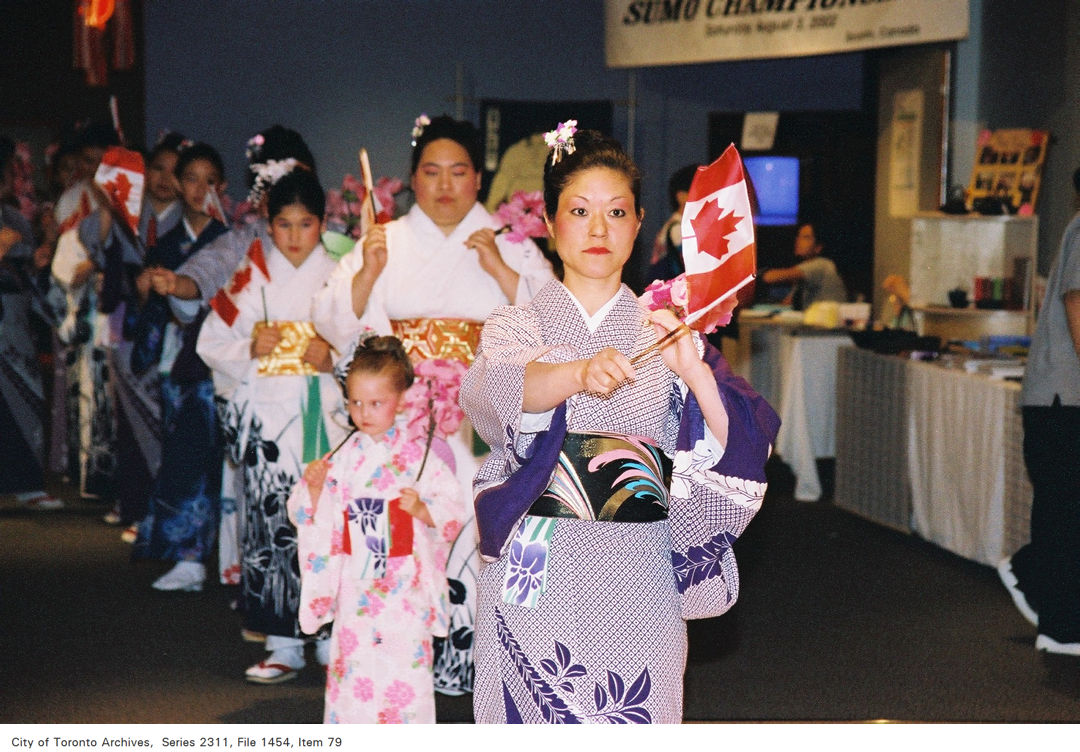
Participants of the Metro Toronto International Caravan, June 2002. Image by Terry Jefford. Courtesy of City of Toronto Archives.
The Founders
From immigrant Ukrainian families, Zena and Leon Kossar became immersed in Toronto’s diverse art and culture scene.
Leon Kossar was born to Ukrainian parents in 1929 in Saskatoon. Shortly after completing a degree with the University of Manitoba, Leon Kossar became a columnist and reporter at The Telegram in Toronto. During his career, Leon chose to focus his stories on the experiences of new Canadians. Eventually, Leon became the executive director of the Community Folk Arts Council of Metro Toronto (CFAC).
Zena Kossar, like her future husband, also came from a Ukrainian background, and was involed with the CFAC in her early career. It was during her time with the CFAC that Zena Kosser proposed the idea that would grow to become the Metro Toronto International Caravan Festival.
This story will unpack how the Caravan festival, together through the work of the CFAC, the Kossars, and the community, worked to create a multicultural festival that celebrated the diverse backgrounds of Torontonians for over 35 years.
… the best way to improve the quality of community life is to educate the population by giving them first hand exposure to other ethnic groups and showing them that all people have the same basic needs and interests.
Community Folk Art Council of Metropolitan Toronto, Mission Statement Manuscript. Toronto, c. 1990. City of Toronto Archives.
Weaving a Cultural Tapestry
The 1960s brought a dramatic increase in cultural diversity and immigration to Toronto.
During the 1960s, Toronto was in the midst of a transitional period. In 1951, the City of Toronto census determined that around 70 percent of the population was of British descent. By 1960, the census determined that this number had dropped to around 40 percent, with an estimated immigrant population of roughly 385,000 people.
This increase in immigration also naturally created an increase in cultural diversity. Several non-English newspapers were being published around Toronto by the latter half of the 20th century. For example, Meie Elu, an Estonian newspaper, began circulating in 1950. El Popular, a newspaper in Spanish from the Latin American community, began circulating by 1970. And in 1972, Voice of Pakistan began publishing newspapers in Urdu.
Furthermore, with cultural communities and enclaves forming across the city, Toronto’s neighbourhoods were becoming representative of traditions from around the globe.
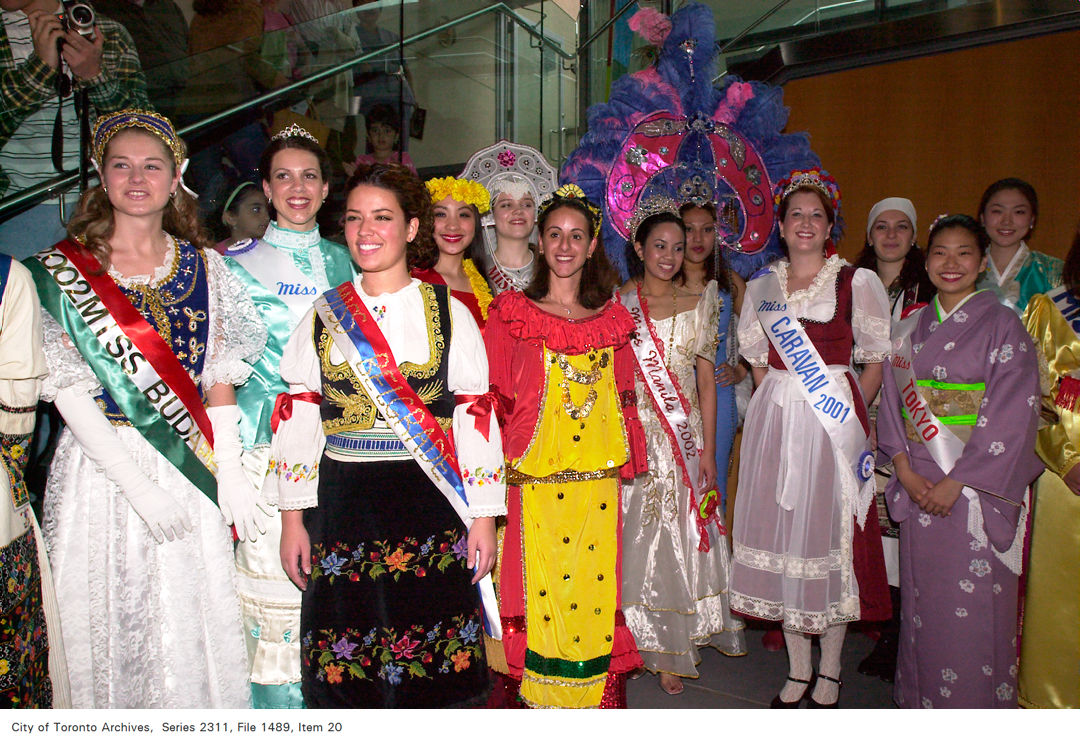
Participants of the Metro Toronto International Caravan, June 2002. Image by Terry Jefford. Courtesy of City of Toronto Archives.
Ideologically, Caravan is relevant to Toronto, reflecting already-established City mottos ‘The World Within A City’ and ‘Diversity Is Our Strength’.
Toronto City Council Economic Development and Parks Committee, Report No. 3 on Toronto International Festival Caravan. Toronto, 2002. Toronto City Council, Report No.3, Clause No. 3.
CFAC: A World of Art in Toronto
The Community Folk Arts Council was essential to the creation of the Caravan Festival.
Founded in 1926, the Community Folk Arts Council (CFAC) of Metro Toronto has strived to preserve the diverse art and culture that shapes Toronto’s heritage. In addition to the Caravan Festival, the CFAC has been responsible for several significant cultural events in the city’s history. One example is an event known as “Easter around the World,” which began in 1965 and displayed Easter traditions from cultures around the world.
In the late 1960s, the CFAC worked with the Kossars to propose an event that would highlight their values as an organization. By 1969, the group had settled on the idea of the Metro Toronto International Caravan Festival. The Caravan Festival would bring together many of Toronto’s immigrant communities, providing Torontonians an opportunity to not only participate, but share and celebrate their unique cultural heritage through dynamic displays at pavilions across the city.
The CFAC has continued to host cultural events in Toronto, many of which utilize dance, song, and artworks to educate participants about the cultural traditions of Toronto’s diverse population, such as a “Winter Culture Night of Folklore Performances” held in January 2023.
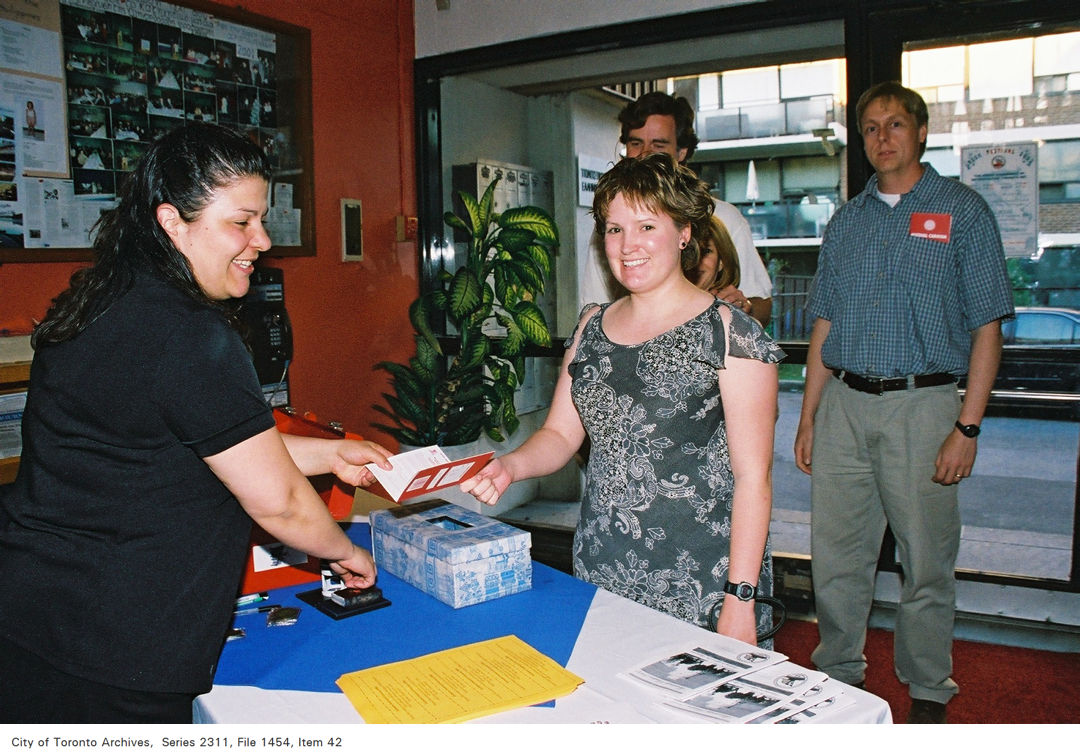
Festival Passport at the Metro Toronto International Caravan, June 2002. Image by Terry Jefford. Courtesy of City of Toronto Archives.
Around the World in a Day
The Caravan Festival offered a rare chance for participants to travel around the world in a day, without leaving Toronto.
After years of planning and fundraising, the first official Metro Toronto International Caravan Festival was held from June 26 to July 1 of 1969, welcoming incredible participation from Torontonians. Around 59 local groups were involved in the first festival. 55 pavilions scattered around the Metro Toronto area hosted programs displaying the dance, music, art, and other traditions of participating cultures.
Municipal buses were hired to run from 6 P.M to midnight on weekdays, and through the afternoon on weekends. These buses carried passengers around to each of the 55 pavilions. The Caravan pavilions were established in community centres and church basements across the city. Participants purchased a “passport,” which gave them unlimited access to the pavilions for the duration of the festival.
The Caravan gained even more popularity in the following years. In 1973, the pavilions recorded approximately 1.3 million visits. In 1974, the festival staff included 5000 volunteers, as well as several full-time and part-time employees.
By October of 1984, the festival even caught the attention of Queen Elizabeth II. On a visit to Toronto that year, she took part in the Caravan celebrations alongside the Mayor of Toronto, Art Eggleton. The Queen and Mayor Eggleton were welcomed at Nathan Phillips Square by a large gathering of eager and excited Caravan participants.
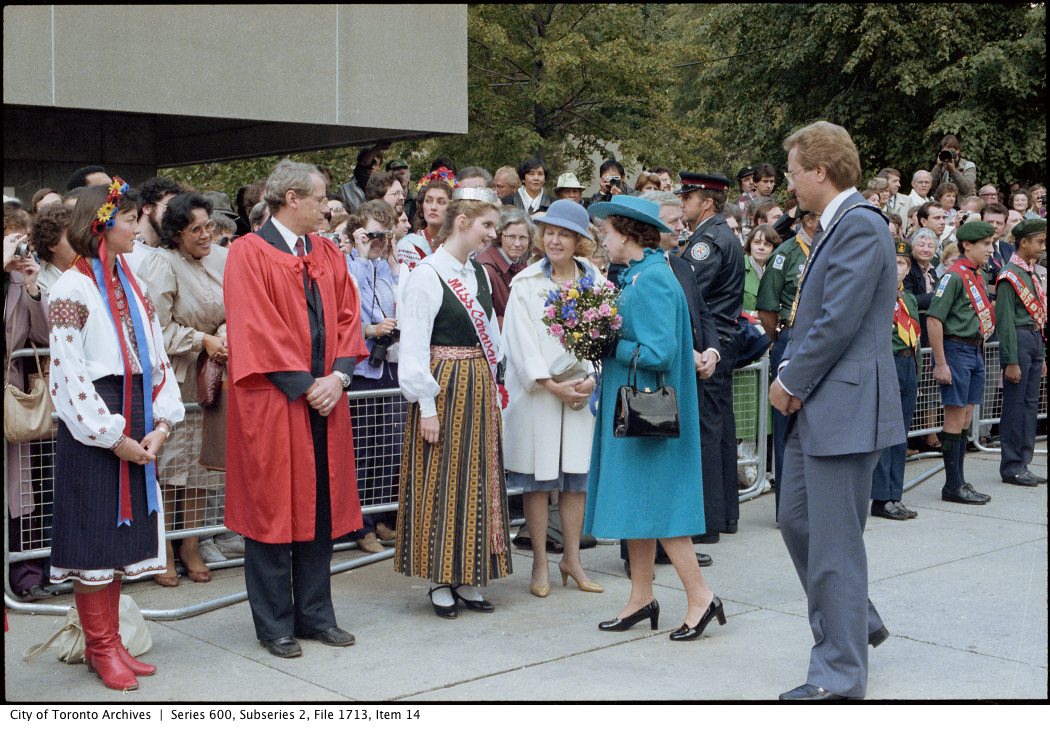
Queen Elizabeth II visits the Metro International Caravan with Mayor Art Eggleton at Nathan Phillips Square, October 1984. Image by Terry Jefford. Courtesy of City of Toronto Archives.
So enthusiastic has Toronto’s response been to Caravan that word has seeped across the border.
NY Times, Robert Trumbull, “Toronto Festival a Showcase for City’s Ethnic Diversity.” June 29, 1974. The New York Times, page 31.
The Caravan Comes to a Halt
After years of success, the Caravan Festival ends due to a decline in community involvement and participation.
In 1978, the Caravan festival hosted an incredible 58 pavilions sharing various cultural traditions from around the world. Twenty years later, in 1997, only 31 pavilions participated in the festival. Only a few years after this, in 2001, 13 pavilions remained. Between 1997 and 2001, the festival’s attendance dropped by 74%, from 99,046 to 25,296 visitors. In response to this dramatic loss, those involved with the Caravan reached out to the Toronto City Council for assistance.
In 2002, the City Council and the Economic Development and Parks Committee met to discuss the Caravan’s future. This meeting considered the financial limitations, the lack of public participation, and the future of the festival, with that year’s festival requiring $105,000 in funding. For the festival to continue, the City Council recommended that the Commissioner of Economic Development, Culture and Tourism work with the Caravan Board and its staff to develop a business plan and budget for future years. However, Leon Kossar had sadly passed away in 2001, one year prior, at the age at 72. Leon and Zena Kossar had remained the driving force behind the Caravan Festival since its beginning. Without this force, the Metro Toronto International Caravan Festival ended in 2003.
The Caravan Festival not only celebrated the multiculturalism in the city, but it educated Torontonians about the unique traditions of their fellow residents, and brought communities together. The Metro Toronto International Caravan Festival also inspired the Carassauga Festival of Cultures in Mississauga. Since 1986, Carassauga similarly allows for visitors to engage with cultures from around the world through visiting different pavilions. As the Caravan festival demonstrated for 35 years, and as festivals like Carrasauga continue to show, Toronto’s cultural diversity is something worth celebrating.
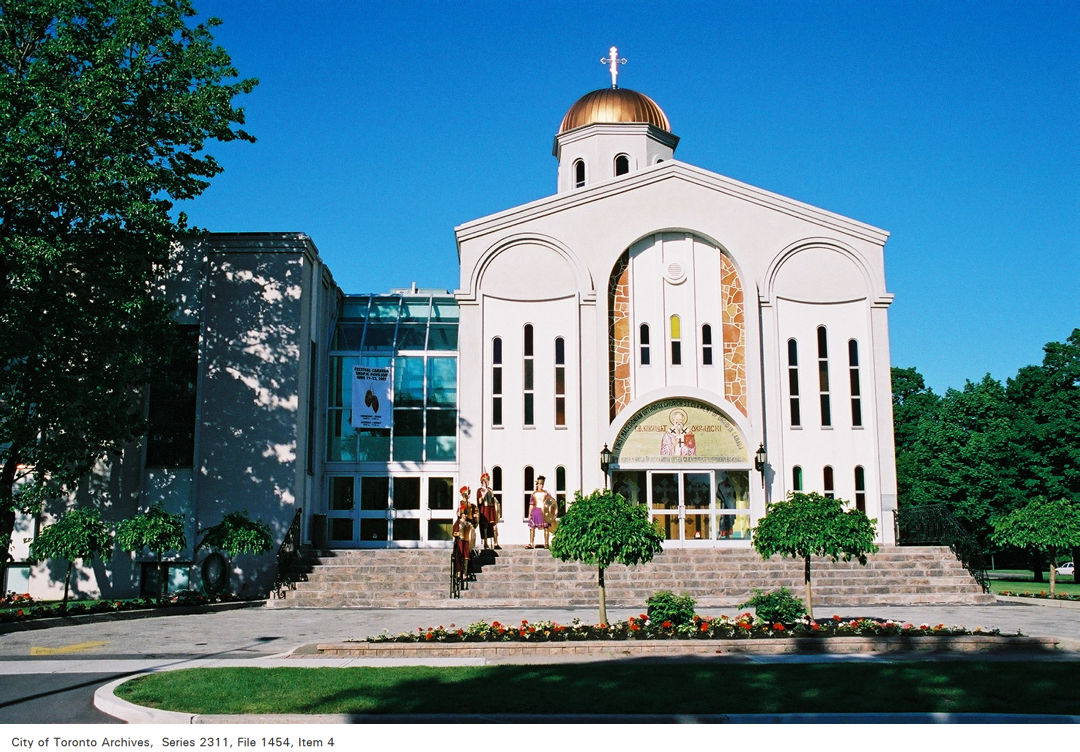
The Metro Toronto International Caravan Festival Skopje Pavilion, June 2002. Image by Terry Jefford. Courtesy of City of Toronto Archives.
Sponsor

References and Further Resources
- “About Us – Community Folk Art Council of Toronto.” Community Folk Art Council of Toronto.
- Community Folk Art Council of Metropolitan Toronto. c. 1990. Mission. Toronto, Ontario.
- Kossar, Leon. 1969. Letter From Leon Kossar to William Dennison. Toronto, Ontario.
- Oziewicz, Estanislao. 2001. “Caravan co-founder Leon Kossar dies.” The Globe and Mail, August 7, 2001.
- Toronto (Ont.) Planning Board. 1961. “Recent City-Wide Changes in Ethnic Composition.” In Ethnic Origins of the Population of Toronto, 3. Toronto, Ontario. City of Toronto Archives.
- Toronto City Council and Economic Development and Parks Committee. 2002. “Toronto International Festival Caravan (Various Wards),” Clause embodied in Report No. 3 of the Economic Development and Parks Committee, as adopted by the Council of the City of Toronto at its meeting held on April 16, 17 and 18, 2002. Toronto, Ontario.
- Trumbull, Robert. 1974. “Toronto Festival a Showcase for City’s Ethnic Diversity.” The New York Times (Toronto), June 29, 1974.
